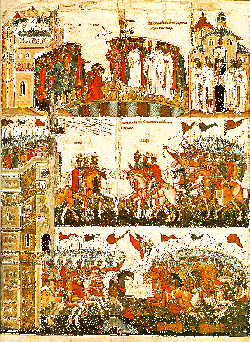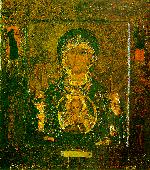
Novgorod School, circa 1450-75.
Novgorod, Museum of History and Architecture, 118 x 161 cm.

The story: The icon describes a miracle performed by the icon of the Virgin of the Sign (shown below), the protector of Novgorod. The icon was kept in the Church of the Transfiguration of the Savior on Ilyina Street. When the forces of the prince of Suzdal, Andrei Bogolyubsky, attacked Novgorod in 1170, the icon was taken from the church and placed on the walls of the city. The evil Suzdalians shot arrows at the icon and it turned its face from them, taking away the light which emanated from it and leaving them in the darkness. Led by the Saints Boris, Gleb, George, and Demetrios of Thessalonica (or Prince Vladimir, Alexander Nevsky, St. George, and an unidentified saint) the Novgorodians were able to defeat the superior enemy force.
According to Hamilton, this painting is the first icon to depict an event "strictly" from Russian history. This icon illustrates the victorious outcome of the battle between the Novgorodians and the Sudalians that took place 300 years earlier. It was painted in the middle of the 15th century, probably in response to the impending threat of Muscovy
to Novgorodian independence. In 1478 Novgorod was forced to become part of Muscovy, and so this icon remains one of the few "representative(s) of the final years of Novgorod's great school of painting, for although standards were maintained during several decades following its integration into Muscovy, yet, on being deprived of its autonomy, Novgorod's art lost much of its impetus" (Rice 104). This icon is both effective aesthetically (in terms of composition, colors, style) and "spiritually" (in terms of ideas and Christian truths it embodies). The division of the panel into three planes (rows) allows the painter to show several moments of action in a simple way, maintaining at the same time an evocative level of detail and
supplying the viewer with sufficient information and imagery to begin to appreciate the meaning of the icon. 
